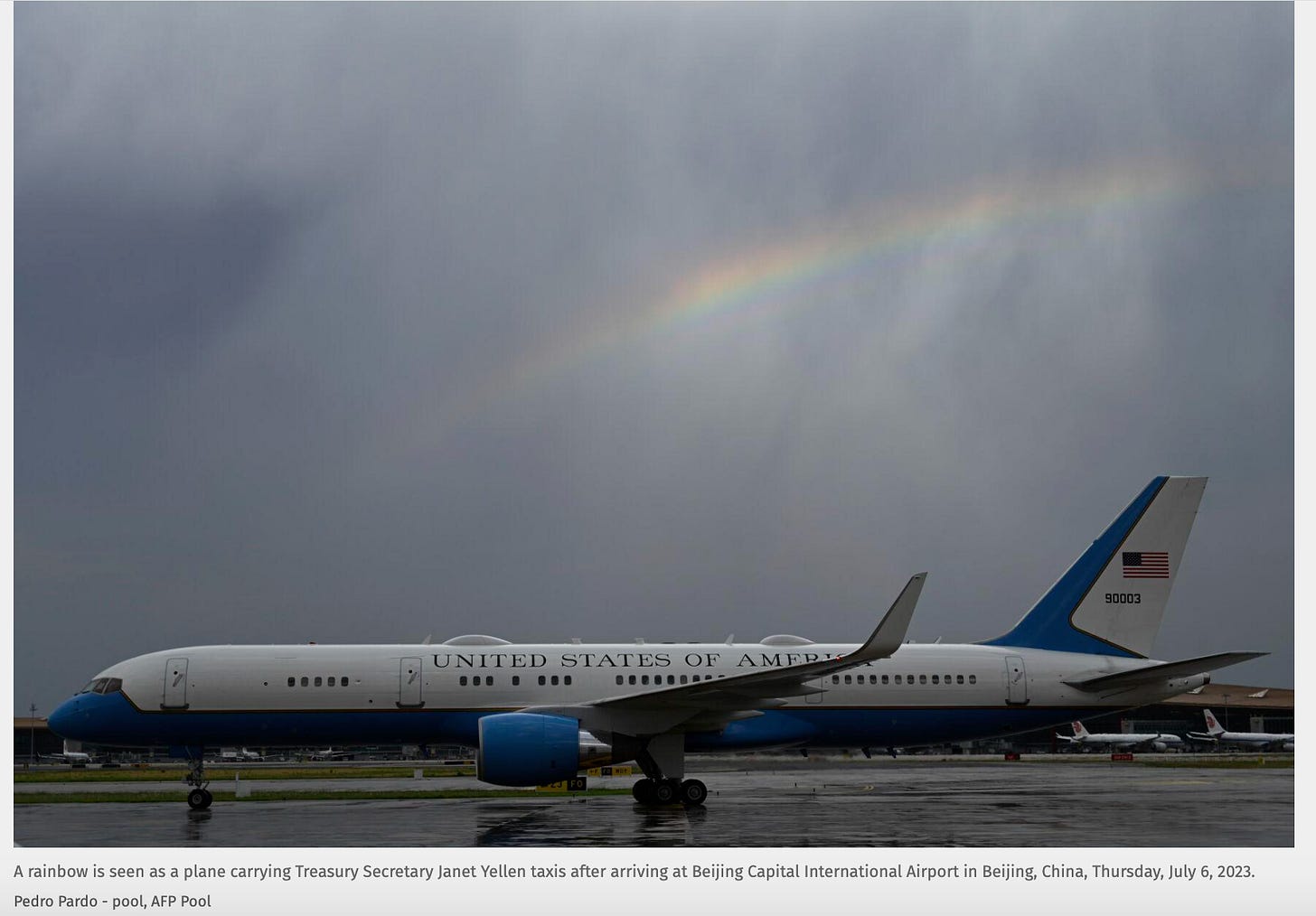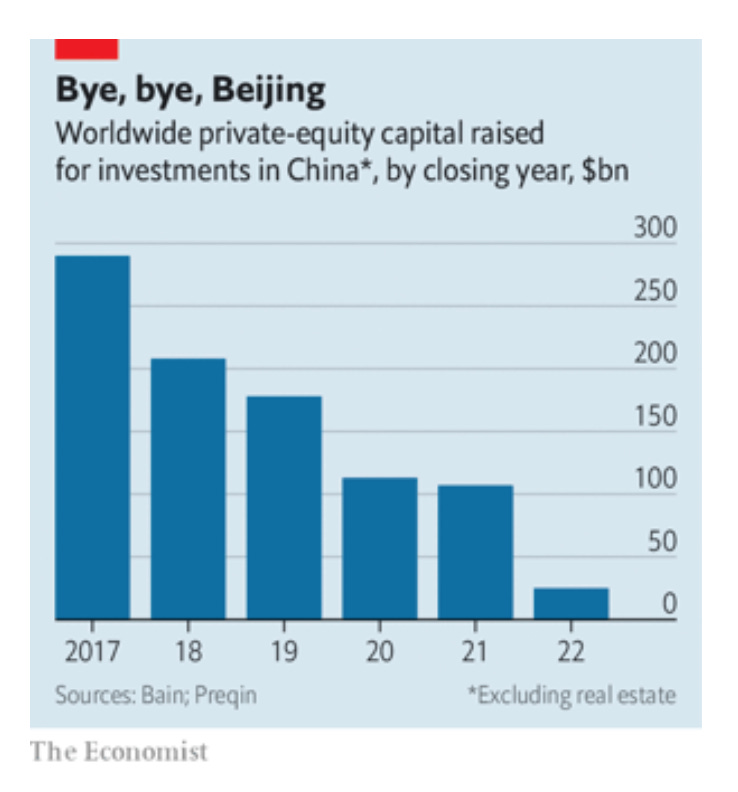Chartbook 225 Not de-escalation, or economic peace, but managed tension: Janet Yellen goes to China.
As Treasury Secretary Janet Yellen’s plane touched down in Beijing, it was greeted by a rainbow.
Yellen’s visit is the latest round of diplomacy through which the Biden administration and Beijing are seeking to manage the escalation of tension between them.
I choose that phrase carefully. I don’t think it is right to call these moves a deescalation, let alone an opening towards a wider settlement of differences. What they do indicate is a desire to manage the tension, which both sides now seem to view as inevitable.
Yellen’s visit follows her speech on Sino-US economic relations of April 20 and Blinken’s visit to Beijing on June 18-19. The fact that contacts have resumed at this high level is itself a breakthrough.
Blinken met with Xi. Yellen had an extended, hour-long conversation with Premier Li Qiang who is credited with having a particular interest in economic affairs.
Yellen, who also served as Fed chair, met with Yi Gang, the outgoing governor of the People’s Bank of China and dined with her old acquaintance Zhou Xiaochuan, who did a legendary stint as the 11th governor of the PBOC between 2002 and 2018. Yellen also met with Liu He, who still has significant influence in Xi’s inner circle, and was instrumental in unleashing the moves against China’s housing bubble in 2021.
Yellen’s meetings with technical economic policy-makers are significant because they highlight the divergence in the Chinese and US business-cycles and their respective monetary policy stances. China is loosening as the Fed is likely to embark on another upward ratchet. The pressure that this exercises on emerging market borrowers was raised in their conversations with Yellen this time. But it is unlikely that Beijing can expect the kind of tacit cooperation that they engaged in with the Fed, when Yellen was chair in 2015-6. On this episode and Yellen’s description of it, is illuminating.
But the main issue at stake in 2023 is not interest rate differentials but the risk of war.
That may sound like exaggeration, but that was literally the theme of Yellen’s April speech. This is how she framed her argument
In recent years, many have seen conflict between the United States and China as increasingly inevitable. This was driven by fears, shared by some Americans, that the United States was in decline. And that China would imminently leapfrog us as the world’s top economic power – leading to a clash between nations.
She brushed that chain of reasoning aside not because war between the US and China is unthinkable but because the presumption of American decline on which the Thucydides trap narrative is based, does not accord with the facts.
It’s important to know this: pronouncements of U.S. decline have been around for decades. But they have always been proven wrong. The United States has repeatedly demonstrated its ability to adapt and reinvent to face new challenges. This time will be no different – and the economic statistics show why.
But for all Yellen’s bullishness about the US economy, the escalation of economic measures and countermeasures between China and the US continues. After rounds of US sanctions on chip producers, China’s commerce ministry announced Monday that starting Aug. 1 China would restrict exports of gallium and germanium — two metals used in semiconductor manufacturing. It is an open secret that the US is considering a blanket ban on investment in certain key sectors in China. This could have a significant impact on venture capital flows which are very significant for China’s start up scene.
Even ahead of any formal ban, key venture players like Sequoia have decided to “derisk” by splitting themselves. And the flow of western private equity funding for China investment has dwindled to a trickle.
The adoption of the concept of derisking by the G7 is part of the strategy of tension management that the Biden economics team are attempting. As far as Europe is concerned derisking can be taken at face value. Berlin does not want to trade less or invest less in China but to spread its investment and trade. The recent visit by Premier Li to Berlin was notably conciliatory with journalists quipping that the presser reminded them of the days of Angela Merkel, except that under Merkel they had been allowed to ask questions.
The US is not in the same boat. The US does not welcome multipolarity for its own sake. When it talks about de-risking it does indeed mean reducing particular types of trade and investment connection between the US and China. What Washington is doing to manage the tension is trying to signal that its economic campaign of containment will be limited to certain key sectors, technologies and firms. As National Security Advisor Sullivan put it, the US will seek to demarcate and defend a small yard with a high fence. The phrase was coined by Bob Gates who served as Defense Secretary to both Bush and Obama and was brought back into circulation in 2021 as an effort to distinguish Biden’s targeted policy from broad-brush decoupling.
As I spelled out in the pages of Foreign Policy it is a tall order to expect China to accept these terms. But that is why we are not in a phase of deescalation or peace-making. We are in a phase of managing tension, tension which may well further escalate. This will be a matter of trial and error, the balloon incident being a case in point. In early March Ed Luce captured the mood in Washington in precise and alarming terms:
… Biden was as easily blown off course last month as a weather balloon. Washington’s panic over what is after all 19th-century technology prompted Antony Blinken, the US secretary of state, to cancel a Beijing trip that was to pave the way for a Biden-Xi summit. Washington groupthink drove Biden’s overreaction. The consensus is now so hawkish that it is liable to see any outreach to China as weakness.
What we have seen since March is no retreat and no substantive deescalation, but rather an effort to manage tension better. This involves communication, probing and testing and it extends across the range of policies and signaling, from economics to hard power and rhetoric such as Biden’s comment about Xi being a dictator.
As far as economic policy is concerned, as a Chinese friend remarked to me, we are in a new era. We are beyond the kind of technocratic fine-tuning that the PBoC and the Fed used to engage in. We are also beyond WTO-style rule-making. We are in a dangerous and open-ended sparring match. Neither side is looking for the knock out punch, but both sides are probing each other, delivering blows serious enough to force a reaction, opening up the range of possibilities with escalatory talk. Removing inhibitions and old assumptions whilst at the same time, seeking to manage what are increasingly serious risks. The entire process is driven by powerful forces on both sides. It is open-ended and has no obvious landing place. But management is better than no-management and visits like that by Yellen are part of that process.
***
Thank you for reading Chartbook Newsletter. It is rewarding to write. I love sending it out for free to readers around the world. But it takes a lot of work. What sustains the effort are voluntary subscriptions from paying supporters. If you are enjoying the newsletter and would like to join the group of supporters click below. As a token of appreciation you will receive the full Top Links emails several times per week.





